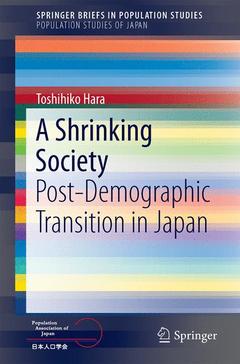Description
A Shrinking Society, 2015
Post-Demographic Transition in Japan
Population Studies of Japan Series
Author: Hara Toshihiko
Language: English
Subjects for A Shrinking Society:
Publication date: 12-2014
65 p. · 15.5x23.5 cm · Paperback
65 p. · 15.5x23.5 cm · Paperback
Description
/li>Contents
/li>Comment
/li>
This is the book to focus on a new phenomenon emerging in the twenty-first century: the rapidly aging and decreasing population of a well-developed country, namely, Japan. The meaning of this phenomenon has been successfully clarified as the possible historical consequence of the demographic transition from high birth and death rates to low ones. Japan has entered the post-demographic transitional phase and will be the fastest-shrinking society in the world, leading other Asian countries that are experiencing the same drastic changes. The author used the historical statistics, compiled by the Statistic Bureau, Ministry of Internal Affairs and Communications in 2006 and population projections for released in 2012 by the National Institute of Population and Social Security Research, to show the past and future development of the dependency ratio from 1891 to 2060. Then, utilizing the population life table and net reproduction rate, the effects of increasing life expectancy and declining fertility on the dependency ratio were observed separately. Finally, the historical relationships among women?s survival rates at reproductive age, the theoretical fertility rate to maintain the replacement level and the recorded total fertility rate (TFR) were analyzed. Historical observation showed TFR adapting to the theoretical level of fertility with a certain time lag and corresponding to women?s survival rates at reproductive age. Women?s increasing lifespan and survival rates could have influenced decision making to minimize the risk of childbearing. Even if the theoretical fertility rate meets the replacement level, women?s views of minimizing the risk may remain unchanged because for women the cost?benefit imbalance in childbearing is still too high in Japan. Based on the findings, the author discusses the sustainability of Japanese society in relation to national finances, social security reform, family policies, immigration policies and communitypolices.
1 Introduction: The Demographic Impacts from the Great East Japan Earthquake (The Tōhoku Earthquake and Tsunami; The Demographic Impacts; Comparing the Population Projections: Prefectures Level; Comparing the Population Projections: Cities Level; Impacts of the Great East Japan Earthquake; About This Book).- 2 Population Prospects in Japanese Society (From Population Growth to Population Decline; Changing Dependency Ratios as Indicators of Child/Elder Care Cost; Depopulation at Sub-national Level: Shrinking Regions).- 3 Demographic Transition and Child/Elder Care Cost (Optimal Care Cost and Net Reproduction Rate; Historical Change of Optimal Care Cost Curves; The Effects of the Rising Longevity on the Child/Elder Care Cost).- 4 Historical Process and Background of Fertility Decline in Japan (Female Life Expectancy and Survival Rate of Women; Fertility Effects of the Rising Survival Rate of Women of Reproductive Age; Mean Number of Children Ever Born to Women; Decreasing Number of Children; Causal Model of Demographic Transition in Japan; Condition for Recovering the Replacement Fertility Level).- 5 Sustainability of Japan as A Shrinking Society (Increasing Conflicts on the Redistribution between Different Social Groups ; Collapse of Nation's Finances; Social Security Reform).- 6 Policy Measures for A Shrinking Society (Family Policies for Recovering Replacement Fertility; Immigration Policies for Globalization of Japanese Society; Selections and Re-Concentration of Communities).- 7 Epilogue: The Principle of the Sustainable Population (The Principle of the Sustainable Population; Conclusion).
Focuses on Japan as a shrinking society, a new phenomenon emerging in the twenty-first century Clarifies the historical background of the aging and decline of Japan’s population in the context of demographic transition Discusses the demographics of the sustainability of Japanese society in relation to national finances, social security reform, family policies, immigration policies and community polices Includes supplementary material: sn.pub/extras
© 2024 LAVOISIER S.A.S.




